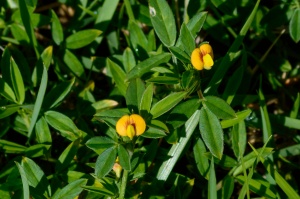Anguilla, northern-most of the lesser Antilles in the Caribbean, is an eel-shaped island about 16 miles long and three miles wide, consisting mostly of a two hundred foot thick layer of limestone over an igneous base. There’s not much elevation change (highest point is about 210 feet above sea level), no springs or streams, and only a little fertile soil. The resulting vegetation is what you’d expect: low-growing, scrubby stuff adapted to harsh conditions.
Maybe 120 of the almost 500 plant species found on Anguilla are thought to be alien, but reports vary. One source theorizes that aliens have had a difficult time establishing on Anguilla because there were never any large plantations offering more hospitable starting places.
Steve and I were there for four days in mid-January. There aren’t any hiking trails as such, but we walked to some uninhabited areas anyway. I brought an older camera and did a lot of point-and-shoot photography, and have identified about 24 species of flowering plants, because even though we were supposed to be relaxing, I can’t resist botanizing in a new place.
The pea and morning glory families were well represented.
Canavalia rosea (Fabaceae)
Now that’s a papilionaceous flower if ever I saw one. This vine is found in tropical regions worldwide and goes by the names bay bean, beach bean, cow bean, sea bean, vonvon, and who knows how many others.
Centrosema virginianum (Fabaceae)
This one has many common names, among them blue bell also known as wild pea, pwa pwa, butterfly pea, and winer. It’s native to tropical and subtropical regions of South and North America, including Maryland (in the coastal plain). When I spotted it I was immediately reminded of Atlantic pigeonwings (Clitoria mariana.)
Desmanthus virgatus (Fabaceae)
A short shrub native to tropical and subtropical regions of the Americas, with a million common names, among them wild tantan and dwarf koa.
Stylosanthes hamata (Fabaceae) Cheesytoes is native to tropical and subtropical North America. I found it growing as a lawn weed and as such, the plants were very compact and short, but it can get to about two feet tall, and is apparently an important forage species. There are at least two dozen other names for this species, including Caribbean stylo, lady’s fingers, sweet weed, and wild clover.
Merremia dissecta (Convolvulaceae) Cut-leaf morning glory is a native of the Americas, now established in tropical and subtropical regions worldwide. Other common names include noyau vine, bini bini, nora vine, saba spice bush, and alamo vine. I found in growing inland, not right along the beach like so many of these plants.
Ipomoea eggersii (Convolvulaceae) “Almost endemic” according to the Plants of the Eastern Caribbean website, jumby potato is a vine of coastal forests and scrubs, found in the Lesser Antilles, Virgin Islands, and a few other Caribbean islands.
Ipomoea pes-caprae (Convolvulaceae) This fast-growing vine can reach lengths of thirty feet and can be found in tropical and subtropical beach areas worldwide. It’s considered a noxious weed in Arkansas and Arizona. Common names include beach morning glory, railroad vine, bayhops, and goat’s foot.
sources
Plants of the Eastern Caribbean
Anguilla Environmental Profile
Geology and Botany of Anguilla
next time: more Anguillan wildflowers









